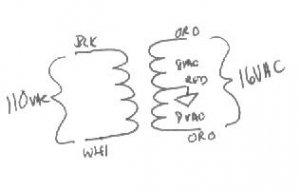I am about to wire in a Transformer and I need some advice. The Transformer is bare bones and I've bought most of the parts to complete it -- plastic box, fuse, switch, line cord.
Peter Thorne's book shows a wiring diagram where the is a fuse in one line and a switch in the other. Is this right? I think they should both be in the hot side.
Which is the hot side of the line cord? wide plug or narrow?
There are 3 output wires. Which ones do I use? It's labelled "16v C.T." Is that Centre Tap? What's that?
I plan to mount the transformer on the outside of a plastic project box and have all the wiring connections inside. The assembly will be at the back of the layout, out of the way.
Thanks for all advice.
Peter Thorne's book shows a wiring diagram where the is a fuse in one line and a switch in the other. Is this right? I think they should both be in the hot side.
Which is the hot side of the line cord? wide plug or narrow?
There are 3 output wires. Which ones do I use? It's labelled "16v C.T." Is that Centre Tap? What's that?
I plan to mount the transformer on the outside of a plastic project box and have all the wiring connections inside. The assembly will be at the back of the layout, out of the way.
Thanks for all advice.


